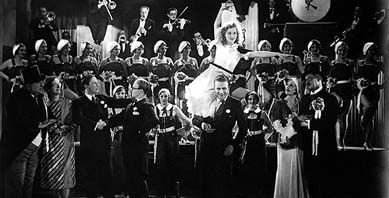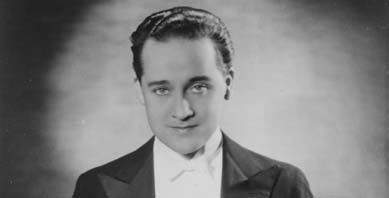The Musical Comedy
The triumph of the talking picture brought with it the rise of comedic forms that were especially dependent on sound. As late as January 1930, with a view to Hollywood musicals, the magazine Lichtbild-Bühne demanded that filmmakers "give us the German Talking-Picture Operetta!" Only eight months later, "Die Drei von der Tankstelle" (The Three From the Filling Station) had its premiere and went on to become the most successful film of the season. With hits like "Ein Freund, ein guter Freund" (A Friend, a Good Friend) and "Liebling, mein Herz läßt Dich grüßen" (Darling, My Heart Says Hello) written by Werner Richard Heymann and sung by Willy Fritsch, Oskar Karlweis, Heinz Rühmann, and Lilian Harvey, the film turned out to be the first pinnacle of a new form of comedy.

Combining features of the operetta, the Lustpiel, and earlier films about singers and musicians, the new form was introduced as both the "operetta talkie" and the "musical comedy". "In place of the ponderous operetta tradition", wrote Ernst Jäger in Film-Kurier at the end of 1930, "we are witnessing the birth of the musical comedy, a style of entertainment particular to the new German middle class." This "particular style" would be developed in countless films, availing itself not only of the resources of the stage operetta and the urbane elements of silent film. Opera, cabaret, jazz and swing music, dance halls, chorus lines, variety shows, bars, fashion magazines, and various stimuli from contemporary popular culture all left their mark on this form of musical sound-film. Its variety was reflected in productions like "Die singende Stadt" (The Singing City) and "Das Kabinett des Dr. Larifari" (The Cabinet of Dr. Larifari; both 1930), "Der Kongreß tanzt" (Congress Dances, one of the most successful films of 1930/31), Joe May's "Ihre Majestät die Liebe" (Her Majesty Love, 1931), and "Die Koffer des Herrn O.F." (The Trunks of Mr. O.F., 1931), which boasted song lyrics by Erich Kästner. Lilian Harvey and Willy Fritsch, both under contract with Ufa, were the "dream couple" of this new movement in film. Their success with "Die Drei von der Tankstelle" continued in films like the musical marriage comedy "Einbrecher" (Burglars, 1930), "Ein blonder Traum" (A Blonde's Dream, 1932), and "Glückskinder" (Lucky Kids, 1936). It ended only in 1939, with Lilian Harvey's emigration from Nazi Germany. Other musical comedy stars included the Polish tenor Jan Kiepura, his equally well-loved co-star and later wife Marta Eggerth, actor-director Willi Forst, opera star Richard Tauber, actor, singer, and cabarettist Max Hansen, and the Hungarian opera and operetta singer Gitta Alpar. Performing songs by composers like Friedrich Hollaender, Werner Richard Heymann, Robert Stolz, and Theo Mackeben, they and many other made this body of musical work a firm fixture in the entertainment culture in the Weimar Republic.

During the Third Reich, sound-film operettas and musical comedies continued to enjoy success, even those not starring Fritsch and Harvey. The new stars included Marika Rökk and Johannes Heesters. But the self-reflexive moments of film-in-a-film satires like "Das Kabinett des Dr. Larifari" and Max Ophüls' "Die verliebte Firma" (The Company’s In Love, 1931) abated, as did the (post-)modern games with fiction and reality and with conventions and traditional gender roles (as in "Viktor und Viktoria" [1933]). This occurred just as National-Socialist repression and persecution were worsening. With Hans H. Zerlett's burlesque "Robert und Bertram" (1939) we have a perfectly timed musical comedy that is also a pernicious, anti-semitic musical. The emphatically liberal, self-confident, and self-reflexive charm of musical comedies from the early years of sound film vanished, never to return — not even after World War II, in the countless West German revue films of the 1950s and early 1960s.